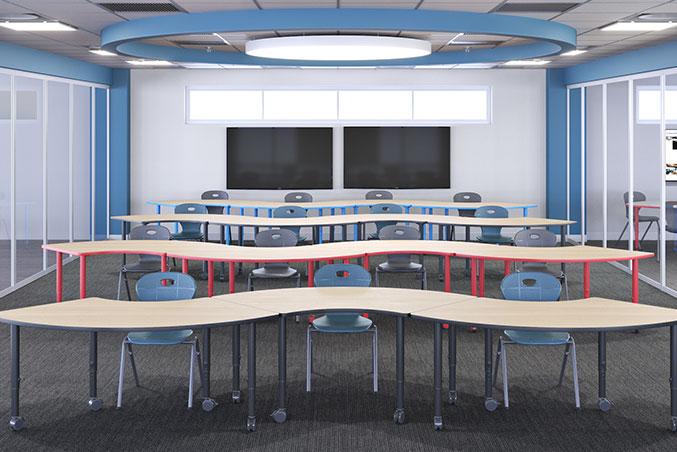Creating a student-centered classroom is crucial for fostering a positive and effective learning environment. One key aspect of achieving this is through the strategic incorporation of furniture. Allied tables and desks provide a quality solution that can enhance the student-centered approach. Additionally, the advantages of mobile tables and desks compared to furniture on glides should be considered, as well as the impact of colors on student engagement. Let’s explore these topics in detail.
Student Desks
Transform modern learning environments into flexible and adaptable spaces with our collaborative school desks. By promoting collaboration, they encourage students to interact, exchange ideas, and work together, fostering effective communication and teamwork.
 Browse Products By:
Browse Products By:

Keep Studying About Our Recommendations for Desks for Schools:
Creating an effective and engaging collaborative learning environment is a priority for educators and institutions, and the right classroom furniture plays a pivotal role in achieving this goal. Collaborative classroom furniture, particularly collaborative student desks, has become an essential component in modern educational settings. These desks are designed to promote interaction, group work, and active learning, creating a dynamic space where students can thrive. When selecting collaborative student desks, a key consideration is the design and layout of the classroom, which can significantly impact the learning experience.
Design and Layout: One of the first considerations when choosing collaborative student desks is how they will fit into the overall design and layout of your classroom. The layout of your classroom is essential to creating an environment that fosters collaboration, engagement, and student interaction. Collaborative student desks come in a variety of shapes and sizes, including rectangular, circular, trapezoidal, triangular and curvilinear shapes. These different designs allow you to create a layout that aligns with your educational objectives and the physical constraints of your classroom. Choosing the right desk top shape can be confusing! We're here to help.
Shapes for Group Work: Collaborative desks are specially crafted to facilitate group work. Triangular and curvilinear desk shapes, in particular, are well-suited for this purpose. Triangular desks can be arranged in clusters, forming small groups where students can easily see and interact with one another. The unique shape encourages active participation and communication. Curvilinear desks, on the other hand, provide versatility in group arrangements. They can be configured into semi-circles or curves, allowing students to face each other and collaborate effectively. These designs are ideal for brainstorming sessions, team projects, and discussions.
Pairs and Individual Work: Collaborative student desks are not limited to group activities alone. They are equally effective for pairs and individual work. Rectangular desks can be used for one-on-one collaborations or individual assignments. When needed, they can be easily grouped together to form larger workspaces, adapting to the specific learning task at hand. The flexibility of these desks makes them suitable for a wide range of teaching methodologies, ensuring that the classroom layout remains versatile and adaptable.
Pedagogical Alignment: One critical aspect to consider when selecting collaborative student desks is how your pedagogical approach aligns with the number of students at each grouping of desks. Different teaching methods may require varying group sizes. For example, problem-based learning might necessitate smaller groups, while cooperative learning strategies could involve larger groups. Collaborative student desks should offer the flexibility to accommodate these diverse needs.
Space Efficiency: The square footage of your classroom compared to the footprint of the grouping of desks is another crucial factor. It's essential to optimize the use of your classroom space efficiently. Collaborative desks should fit comfortably while allowing for smooth movement within the room. Consider how different desk layouts can maximize the available space and create an environment that encourages collaboration without overcrowding.
Whether you are looking for innovative classroom desks or versatile collaborative solutions, these considerations should guide your decision to create a dynamic learning environment that empowers both educators and students. We're here to help if you have questions!







